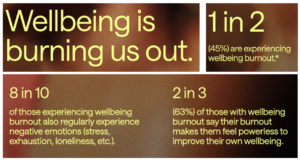Lululemon has published the 2024 Global Well-Being Report, a study into peoples’ perspectives on their personal health from the company best known for athleisure wear and self-care.
This year’s report is titled, The Pressure to Be Well. That pressure is coming from peoples’ experiencing “well-being burnout.”

In the company’s fourth annual report on well-being, Lululemon learned that most people have tried to adopt personal strategies to bolster their health, and one-half of these folks are confronting “well-being burnout.” Lululemon collaborated with Edelman Data & Intelligence to field the study in April and May 2024 in 15 markets where the company operates including Canada and the United States in North America; France, Germany, Spain, and the United Kingdom in Europe; Australia and New Zealand; and, Mainland China, Hong Kong, Japan, Malaysia, Singapore, South Korea, and Thailand.
Among these 15 nations, the top global wellbeing burnout zones were Australia, New Zealand, Canada, Malaysia, and the U.S.
For context, Lululemon characterizes well-being in three components:
- Physical, feeling empowered and able to give one’s body what it needs for health and quality of life
- Mental, feeling emotionally prepared, and able to handle what the future holds, and,
- Social, feeling connected to others, part of something larger than oneself, and contributing to a supportive community.

The data highlights the top pressure points fueling the wellbeing cycle:
- 61% of those surveyed say they experience overwhelming societal expectations to appear well.
- 53% say there is a lot of conflicting information about the best ways to improve wellbeing.
- 89% of those experiencing “wellbeing burnout” say loneliness is a contributing factor — feeling disconnected from their community.

How to combat well-being burnout? Lululemon recommends three strategies:
- Quiet the noise – Focus on mindfulness, take social media breaks and set boundaries. For example, those who practice meditation report 12% higher wellbeing.
- Do what feels good to you – Practice doing things at your own pace, move your body throughout the day, spend time in nature, or use physical activity to socialize. Those who move their body a little throughout the day report 16% higher wellbeing.
- Invite others on your journey – Connect with your community by working out with a friend, sign-up for a team sport or fitness class, or vocalize your needs with your family, friendships, and relationships. Those who use physical activity as an opportunity to socialize with others report 23% higher wellbeing.

This last point is a major message emerging from this year’s research. While the data highlight the wellbeing pressures, an intersection of community and movement can help break the cycle and improve wellbeing. Through the simple act of moving with others, individuals can feel more connected to their communities, become rooted in purpose and improve overall wellbeing.
Health Populi’s Hot Points: What’s particularly encouraging is the message that “well-being can be bite-sized and fun.” That is, we don’t have to enter Iron Man/Woman competitions, train to run marathons, or be gym-rats every day to derive a positive impact for our well-being. “Bite-sized and fun” can translate to small bursts of movement or exercise each day, short walks, or especially powerful, using physical activity to socialize with other people.
A key to reversing wellbeing-burnout is attending to our social connections, especially to connect with people with whom we can share a full range of emotions, and not pretend to be happy when we are not feeling so jolly.
The bottom line: those who are more connected to their community report 16% greater well-being and are more likely to feel a sense of purpose.
The takeaway: “Community powers purpose.”
We can’t expect the health care system alone — hospitals, physicians and nurses, pharmacists and life science companies — to solve this problem for patients and caregivers. Community-powering-purpose is a public-private ecosystem solution — with public policy certainly supportive of community, kindness, and equity — with private sector playing relevant roles to support their consumer-citizen-patient stakeholders’ well-being.




 I love sharing perspectives on what's shaping the future of health care, and appreciate the opportunity to be collaborating once again with Duke Corporate Education and a global client on 6th May. We'll be addressing some key pillars to consider in scenario planning such as growing consumerism in health care, technology (from AI to telehealth), climate change, and trust -- the key enabler for health engagement or dis-engagement and mis-information. I'm grateful to be affiliated with the corporate education provider
I love sharing perspectives on what's shaping the future of health care, and appreciate the opportunity to be collaborating once again with Duke Corporate Education and a global client on 6th May. We'll be addressing some key pillars to consider in scenario planning such as growing consumerism in health care, technology (from AI to telehealth), climate change, and trust -- the key enabler for health engagement or dis-engagement and mis-information. I'm grateful to be affiliated with the corporate education provider  Thank you FeedSpot for
Thank you FeedSpot for